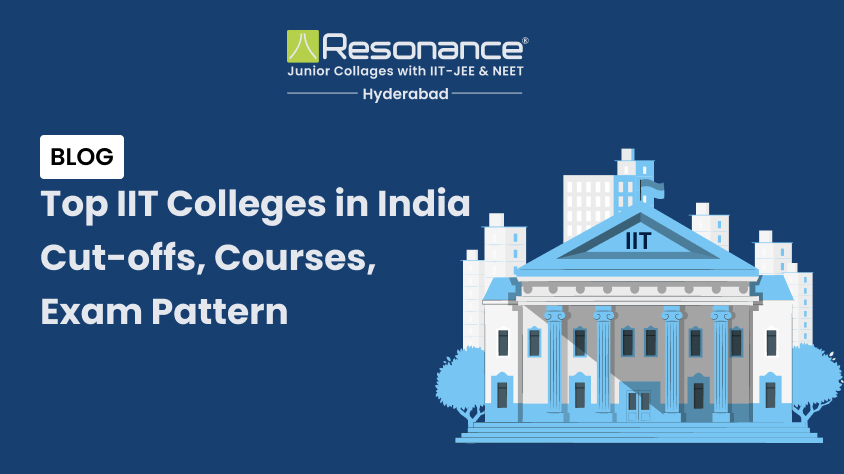- Resonance
- 716 Views
Top IIT Colleges in India 2025 – NIRF Ranking, Courses, Fees & Cut-Offs

With the evolving JEE advanced exam in May 2025, aspirants become inquisitive to know the probable institution that one can opt for, based on the rank profile. There are 24 top IIT colleges in India and JEE advanced candidates or qualified candidates would rush for the NIRF immediately after qualifying in their written exams. National Institute of Ranking Framework, has designed a measuring parameter to judge the rank position of the 24 IITs in India. The selected JEE advanced aspirants can make the best choice to join the course of their interest depending on the rank obtained in the JEE Advanced exam. Aspirants can plan ahead in deducing the best college to the rank obtained and the stream of course that suits their appetite.
The information posted provides the list of the NIRF and parameters that are inclusive in defining the ranks of the IIT institutions. Further reveals the cut-off, exam, and fees for the chosen course from a broader perspective. Another most important parameter IIT aspirants view is the Return on Investment, ROI levied on the student when pursuing the technological courses at the IIT campus.
NIRF has been built on standard rules and regulations that determine the ranking of the IITs within a framework. The institution picks up top-ranking universities and colleges of different streams and publishes them in categories of various streams such as Medicine, Engineering, Arts, Humanities, and so on. The ranking procedures include institutional support to disciplines at work, student and faculty performance, ease of governance, graduation enrollment from outside the state, within the state, and overseas centers, and, in addition, the degree of inclusiveness of the universities.
To prepare the ranking list, NIRF compiles information from various sources based on a predefined questionnaire and adopts specific methodologies and metrics to generate the output report. NIRF ranks institutions based on five broad generic parameters: teaching, learning, resources, research and consulting and collaboration, graduation outcome, outreach and inclusivity, and perception. Such a report becomes the basis for the JEE advanced aspirants to choose the institution and trade suitable for them.
5 - IIT Campuses | FEES | Total Number of SEATS
IIT has 24 campuses across the country and each campus has predefined courses, fees structure and number of seats and below is the list of five IIT institutions located in Madras, Delhi, Bombay, Kanpur, and Kharagpur.
S.No | IIT Campus | Fees | Total Number of Seats |
1 | IIT Madras | INR 8 lakh | Seats: 1,078 |
2 | IIT Delhi | INR 8 lakh | Seats: 1,209 |
3 | IIT Bombay | INR 8 lakh | Seats: 1,351 |
4 | IIT Kanpur | INR 8 lakh | Seats: 929 |
5 | IIT Kharagpur | INR 8 lakh | Seats: 2,639 |
Courtesy: Internet Websites
Students who get qualified in JEE main and JEE advanced, and someone having passed class 12 and possessed at least 75 % aggregate can dream to apply at any of the 24 institutions of Indian Institute of Technology. In the tabular column, students intending to join in any of the mentioned campuses, say, Madras, Delhi, Bombay, Kanpur, or Kharagpur will have to remit a fee of INR 8.00 Lakh and the total available seats at each center is in the order of IIT Madras (Seats: 1,078), IIT Delhi ( 1,209), IIT Bombay (1,351), IIT Kanpur ( 929), IIT Karagpur (2,639).
ROI (Return on Investment) : Best IIT Colleges in India
After the completion of the technical course from the best IIT colleges in India, usually, the students are offered campus placement. When a student signs in a placement agreement then the difference in the package earned and the amount spent on studies at the IIT defines the return on investment in a year. Therefore, a student must decide on the purchasing capacity whether one is competent to bear the educational expenses or not. Return on Investment, ROI, is an important factor before one opts to seek an admission in the technological institutions.
National Institute of Ranking Framework
Way back in September, 29 2015, Ministry of Human Resources Development, MHRD, gave approval to National Institutional Ranking Framework, NIRF, to rank institutions across the country. NIRF defines the list of top IITs based on the following criteria: teaching, learning and resources, research and professional practices, graduation outcomes, outreach and inclusivity and the perception of the masses.
Column1 | Column2 | Column3 | Column4 |
IIT Institutions | Stream of Technology | Opening Rank | Closing Rank |
First Round |
|
|
|
IIT Madras | Artificial Intelligence & Data Analytics | 132 | 415 |
IIT Delhi | Biotechnology & Biochemical Engineering | 3677 | 4754 |
IIT Bombay | Aerospace Engineering | 585 | 2388 |
IIT Kanpur | Aerospace Engineering | 2713 | 3495 |
IIT Kharagpur | Agricultural and Food | 5515 | 9906 |
Second Round |
|
|
|
IIT Madras | Chemical Engineering | 2024 | 3927 |
IIT Delhi | Biotechnology and Biochemical Engineering | 3677 | 4819 |
IIT Bombay | Aerospace Engineering | 817 | 2394 |
IIT Kanpur | Biological Sciences and Bioengineering | 5259 | 6791 |
IIT Kharagpur | Agricultural and Food Engineering | 5515 | 10076 |
Third |
|
|
|
IIT Madras | Naval Architecture & Ocean Engineering | 4279 | 7187 |
IIT Delhi | Textile Technology | 4352 | 6028 |
IIT Bombay | Metallurgical Engineering & Materials Science | 2690 | 4175 |
IIT Kanpur | Mathematics and Scientific Computing | 575 | 989 |
IIT Kharagpur | Ocean Engineering & Naval Architecture | 7413 | 8707 |
Fourth |
|
|
|
IIT Madras | Naval Architecture & Ocean Engineering | 4274 | 7187 |
IIT Delhi | Textile Technology | 4352 | 6028 |
IIT Bombay | Metallurgical Engineering & Materials Science | 2690 | 4175 |
IIT Kanpur | Material science and engineering | 4748 | 5845 |
IIT Kharagpur | Mining Engineering | 7431 | 9252 |
Fifth |
|
|
|
IIT Madras | chemical engineering | 4274 | 7404 |
IIT Delhi | Textile Technology | 4352 | 6102 |
IIT Bombay | Environmental Science and Engineering | 3424 | 4718 |
IIT Kanpur | Mathematics and Scientific Computing | 2288 | 3445 |
IIT Kharagpur | Ocean Engineering & Naval Architecture | 7876 | 9098 |
Courtesy : Internet
The above tabular column refers to IITs of Delhi, Bombay, Kharagpur, Kanpur, and Madras. It represents five rounds of the selection list with opening and closing ranks. All the mentioned undergraduate technological courses run for 4 years.
5 - Top IIT Colleges in India & Rank Selections
In India, there are 24 IITs, but here 5-top IIT colleges in India that are spread across various parts of the country have been listed in the tabular form. Students who are getting qualified in JEE Advanced enroll for various four year courses of technology of their concern. Depending upon their ranks and interest one can take an integrated 5 year course or dual degree courses.. Usually, there will be 5 rounds of admissions conducted for the rank holders and in the above tabular column one can observe the opening and closing ranks at the five premiere institutions. This tabular column defines the admission status against the ranks in 2024 and it can be viewed as the probable rank entries for the current academic year 2025.
Conclusion
National Institute of Ranking Framework, NIRF, submits an online and offline report to benefit the JEE Advanced aspirants with information on the best colleges in the ascending order. Students can gain comprehensive information about the best IIT colleges in India and the organisation defines the top IIT colleges in India by evaluating different parameters based on research. The organisation checks for institutional support to various disciplines, the ease of doing administrative work. In addition, NIRF evaluates the student and faculty interactive field of the colleges and ranks them accordingly. Moreover, the degree of enrollment of students from within the state, other states and from foreign countries shall be taken into consideration. Another important feature is the level of inclusiveness of the Universities. In gist, teaching, learning, resources, research and consulting and collaboration, graduation outcome, outreach and inclusivity, and perception.


Recent Posts
JEE Advanced 2026: Exam Pattern, Marking Scheme, Questions & Total Mar
September Tue,2025
Why Resonance e-Learning App is the Best Choice for IIT-JEE & NEET Prep
September Mon,2025
Class 12 Students Smart Strategies for JEE and NEET Preparation
August Tue,2025
Medical Seats 2025: NEET Rank-based AIQ & State Quota Allocation
August Tue,2025










